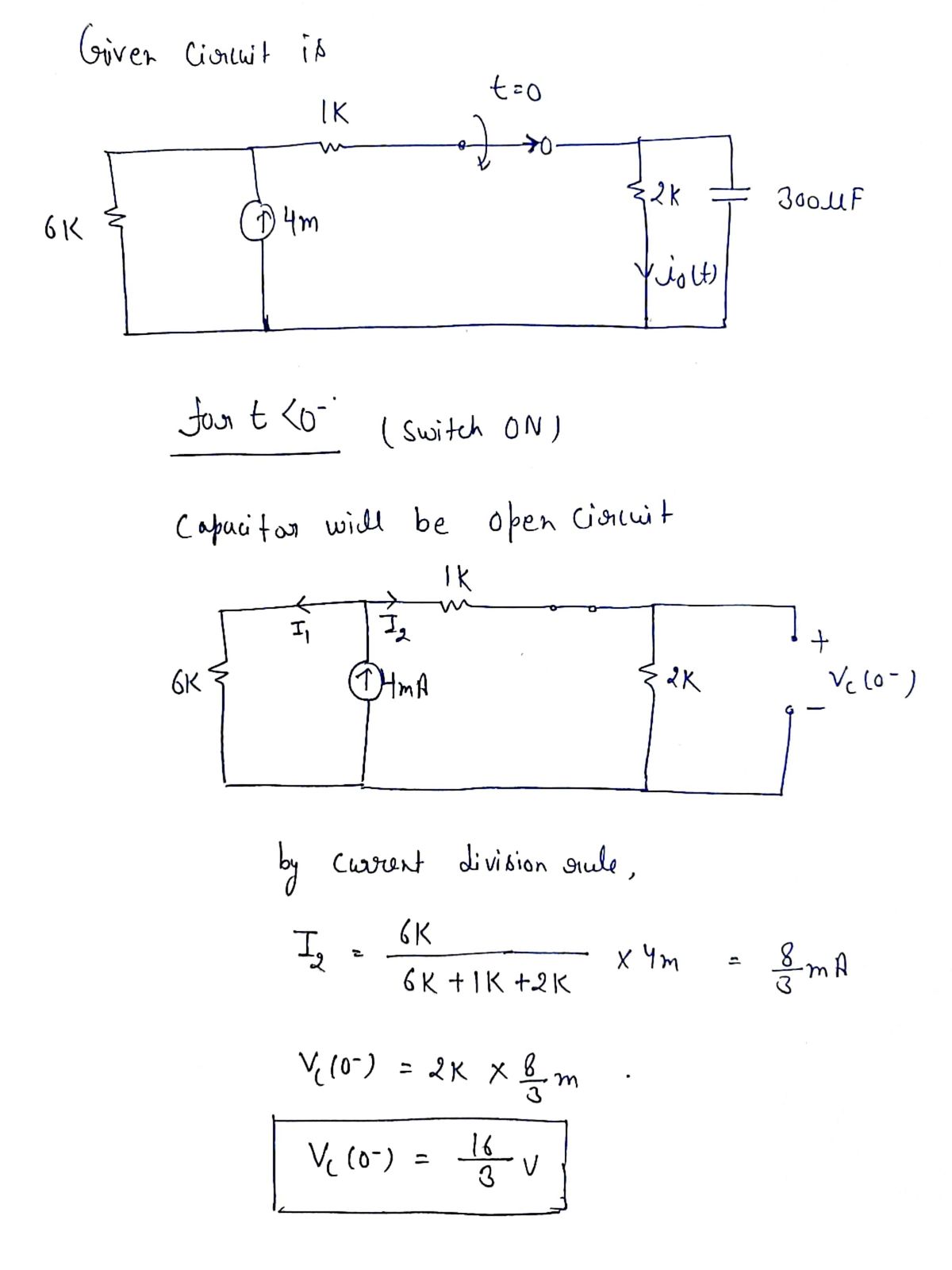ure. 2 ΚΩ 4 ΚΩ Μ Use the differential equation approach to find io(t) for t> 0 in the network in t = 0 1 ΚΩ (1) 4MA 2 ΚΩ i(t) 300 με
ure. 2 ΚΩ 4 ΚΩ Μ Use the differential equation approach to find io(t) for t> 0 in the network in t = 0 1 ΚΩ (1) 4MA 2 ΚΩ i(t) 300 με
Introductory Circuit Analysis (13th Edition)
13th Edition
ISBN:9780133923605
Author:Robert L. Boylestad
Publisher:Robert L. Boylestad
Chapter1: Introduction
Section: Chapter Questions
Problem 1P: Visit your local library (at school or home) and describe the extent to which it provides literature...
Related questions
Question
100%

Transcribed Image Text:**Problem Statement:**
Use the differential equation approach to find \( i_o(t) \) for \( t > 0 \) in the network shown in the figure.
**Circuit Description:**
The circuit consists of the following components:
- A 4 kΩ resistor in series with a 2 kΩ resistor, connected to a node at the top left.
- A current source of 4 mA pointing upwards is connected between this node and a node to its right.
- In series with the current source is a 1 kΩ resistor.
- There is a switch labeled \( t = 0 \) between the 1 kΩ resistor and another 2 kΩ resistor.
- Finally, a 300 µF capacitor is connected in parallel with the 2 kΩ resistor at the far right side of the circuit.
**Objective:**
Determine the expression for \( i_o(t) \), the output current through the circuit, for \( t > 0 \) using differential equations.
Expert Solution
Step 1

Trending now
This is a popular solution!
Step by step
Solved in 4 steps with 4 images

Knowledge Booster
Learn more about
Need a deep-dive on the concept behind this application? Look no further. Learn more about this topic, electrical-engineering and related others by exploring similar questions and additional content below.Recommended textbooks for you

Introductory Circuit Analysis (13th Edition)
Electrical Engineering
ISBN:
9780133923605
Author:
Robert L. Boylestad
Publisher:
PEARSON

Delmar's Standard Textbook Of Electricity
Electrical Engineering
ISBN:
9781337900348
Author:
Stephen L. Herman
Publisher:
Cengage Learning

Programmable Logic Controllers
Electrical Engineering
ISBN:
9780073373843
Author:
Frank D. Petruzella
Publisher:
McGraw-Hill Education

Introductory Circuit Analysis (13th Edition)
Electrical Engineering
ISBN:
9780133923605
Author:
Robert L. Boylestad
Publisher:
PEARSON

Delmar's Standard Textbook Of Electricity
Electrical Engineering
ISBN:
9781337900348
Author:
Stephen L. Herman
Publisher:
Cengage Learning

Programmable Logic Controllers
Electrical Engineering
ISBN:
9780073373843
Author:
Frank D. Petruzella
Publisher:
McGraw-Hill Education

Fundamentals of Electric Circuits
Electrical Engineering
ISBN:
9780078028229
Author:
Charles K Alexander, Matthew Sadiku
Publisher:
McGraw-Hill Education

Electric Circuits. (11th Edition)
Electrical Engineering
ISBN:
9780134746968
Author:
James W. Nilsson, Susan Riedel
Publisher:
PEARSON

Engineering Electromagnetics
Electrical Engineering
ISBN:
9780078028151
Author:
Hayt, William H. (william Hart), Jr, BUCK, John A.
Publisher:
Mcgraw-hill Education,